by Priya Saxena

Etheres, written by Anas Abdulhak, illustrated by Dennis Menheere, lettering by DC Hopkins, and edited by Michele Abounader, is a 30 page comic that follows a woman named Valerie as she traverses the afterlife. The comic juxtaposes written poetry describing Valerie’s journey with enthralling, dreamlike art that depicts the breathtaking and ever-shifting landscapes of the afterlife and how Valerie perseveres through it. Innovative and cathartic, Etheres challenges established notions of how comics can tell stories.
Bitches on Comics had the opportunity to interview Anas Abdulhak and Dennis Menheere about their work on Etheres.
Etheres is available now on Globalcomix or check with your local comic shop or ebay.
Editor’s note: If you enjoy this interview, be sure to join Queer Spec and BoC on Patreon where Anas Abdulhak recommends 3 titles for BoC’s Required Reading, a new feature where we ask comic creators to recommend titles for comics, books, TV, and film that either go with or inspired their comic–without explanation! Join us at any tier–including free!!–to unlock access to this great perk!
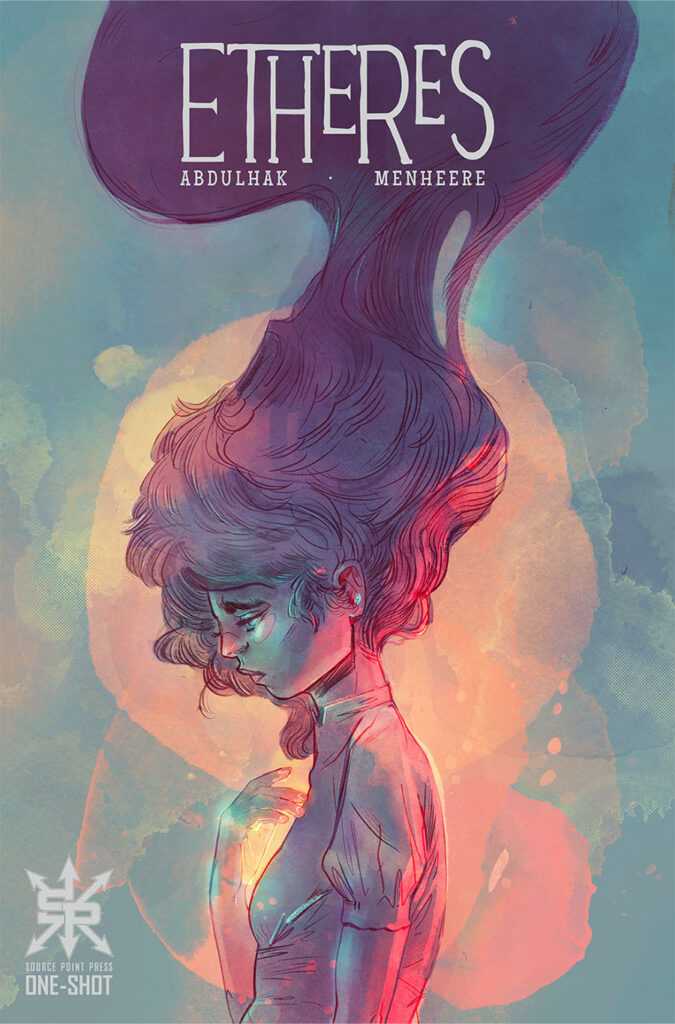
First off, I’d like to ask how this creative team came together. What made the three of you want to work on this story together?
Anas: I stumbled across Dennis’ work completely by accident and was blown away by his use of color and his stylistic approach to inks. I knew immediately that we had to work together on something so I reached out and the rest is history! As for DC, I had been following his work for quite a while and I loved his lettering on Nocterra. I didn’t think I had a shot of him agreeing to work with me, but I thought there was no harm in asking, and I’m so grateful he agreed to be a part of this book!
Valerie’s most defining visual feature is her hair: it floats and wafts around her like smoke, giving her a sense of otherworldliness that fits with the strange, hallucinatory afterlife she now inhabits. The floating hair is such a striking image that it’s featured prominently on the cover of the comic. Where did the idea to give Valerie such dynamic hair come from? What was your thought process in using it as a storytelling device?
Dennis: You mostly hit the nail on the head here. This is not the ‘real’ world where normal laws of nature apply necessarily. I wanted to convey Valerie as if she was in a never ending freefall or floating underwater. It also serves as a dynamic aesthetic, where Val would be standing still observing her surroundings, her hair would still allow it to be a dynamic panel.
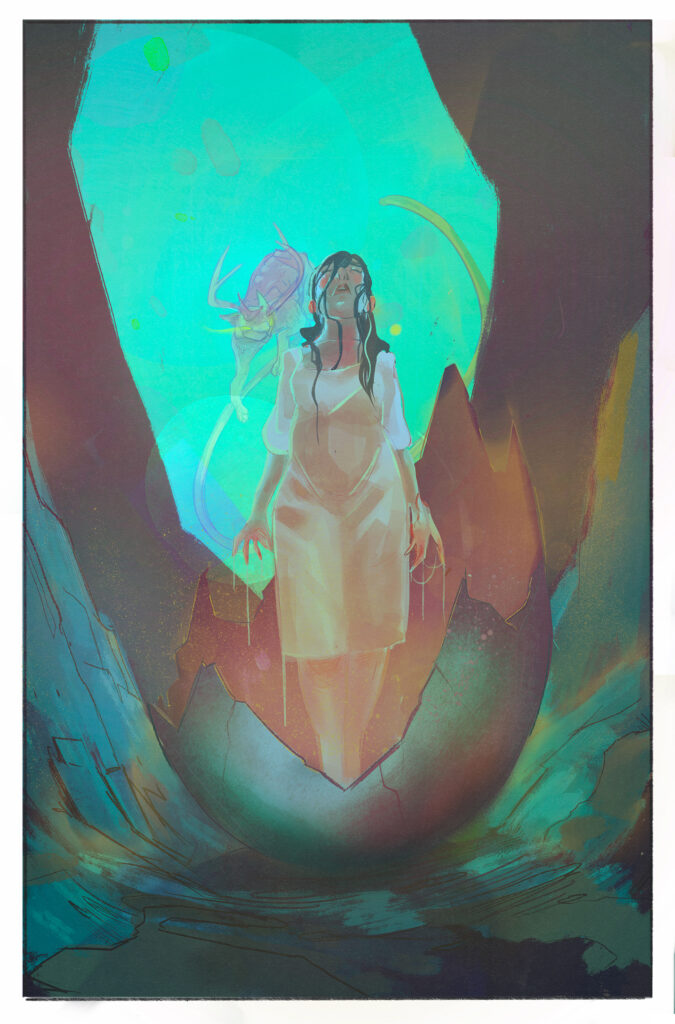
Interspersed within the story are flashbacks to Valerie’s life before she died. Each flashback is encapsulated in a single splash page, and they’re some of the most poignant, arresting images in the whole comic. What was the thought process behind incorporating these flashbacks? How did you decide exactly what aspects of Valerie’s past life to portray, and how to depict them on the page?
Anas: When I started writing Etheres, the poems in these splash pages were actually the first thing I ever wrote. I had recently lost my father and was processing his passing through poetry. It was easier for me to project these thoughts and feelings I had onto a fictional character and imagine how they would deal with this kind of loss. And so Etheres was born.
As for the images in the flashbacks, after weaving the story of Valerie’s journey through the afterlife, we wanted to include some imagery that would inform her feelings about herself but we also wanted to keep them vague enough so that readers can see themselves reflected in these memories and fill in the gaps with their own experiences. There is a hidden meaning to those flashbacks that is personal to me, but as we say in Arabic: “the true meaning is in the heart of the poet”.
Etheres is narrated in a similar poetic style to Objects in the Mirror (also written by Anas Abdulhak). Both comics also deal with heavy, emotional topics brought to life through art that is somewhat abstract and dreamlike. However, Etheres has more in the way of a straightforward plot. What were the challenges of marrying your poetic writing style to a story with a definite beginning, middle, and end?
Anas: It was definitely a challenge. Up to this point, all my previous comics were very abstract and vague. Which was a very intentional move on my part because I was writing these stories to process some very heavy emotions. But when it came to Etheres, I felt like Valerie’s story could resonate with a lot of people, and I wanted to make it more approachable and accessible to readers who may not be familiar with my style of storytelling. So I wanted to give them a space to process feelings of self-loathing, loss, and regret through Valerie’s journey. Mixing the linear plot with poetry was challenging because they had to inform one another and paint a full picture of Valerie’s life before and after her passing.
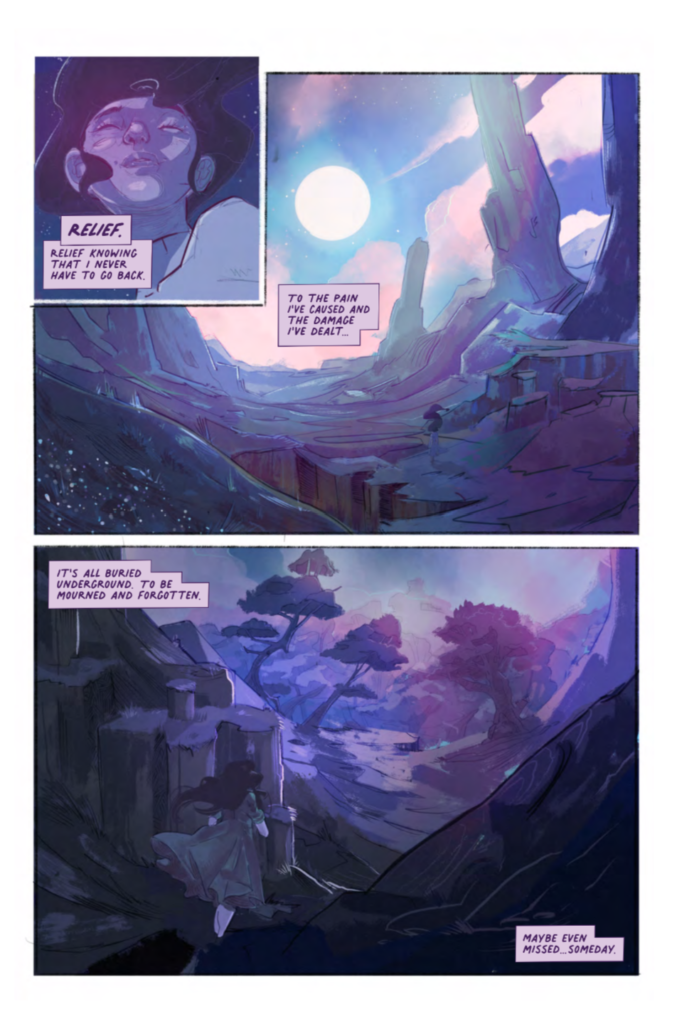
I’ve seen plenty of depictions of the afterlife in comics and other media, but none that looked quite like this. Over the course of Valerie’s journey, we see a range of unreal geography: predatory forests, a sparkling silver lake, a mountain made of skin. How did the look of the afterlife change and develop through collaboration within this creative team?
Dennis: Oh the Silver lake. I recall Anas altering the lake to be made of silver specifically to give me a challenge, and probably because I love Silver Surfer. But I feel Anas had a clear vision for the environments and what they symbolize, and basically let me go nuts with them.
Anas: The Silver lake was definitely something I envisioned after seeing Dennis’ gorgeous colors. I knew he would knock it out of the park with his interpretation and he absolutely did. As for the forest, I loved the visual of having tree branches framing the panels and being used as a storytelling device as well as a visual one. This was definitely inspired by the incredible work of Haden Blackman and J. H. Williams III on Batwoman and seeing their creative use of paneling.
The mountain actually came to me in a dream. I recall dreaming of a wilting flower buried under a mountain of skin. And I wanted to liberate that flower so desperately and give it the air and sun it needed, so I began peeling back layer after layer of skin until I finally reached the flower. The visual of the layers of skin really stuck with me so I wanted to include it in Etheres!
If readers want to learn more about you and your comic work, where can they find you online?
Anas: I’m currently working on crowdfunding unSEEN/unHEARD: Disability & Neurodivergence comic anthology on Kickstarter, it’s a 64-page book that collects 12 new slice of life, romance, sci-fi, fantasy, and horror short comics about dealing with disabilities or being neurodivergent. We’re very excited about this book and I may be biased, but I truly think every single one of these stories is important and so, so good. We would appreciate any support for the campaign!
You can find me everywhere at anas_abdulhak. Dennis can be found at dennismenheere. And dc_hopkins for DC Hopkins! As for our wonderful editor Michele Abounader, she’s cerealpancake on twitter, and ilikepancakes on instagram!
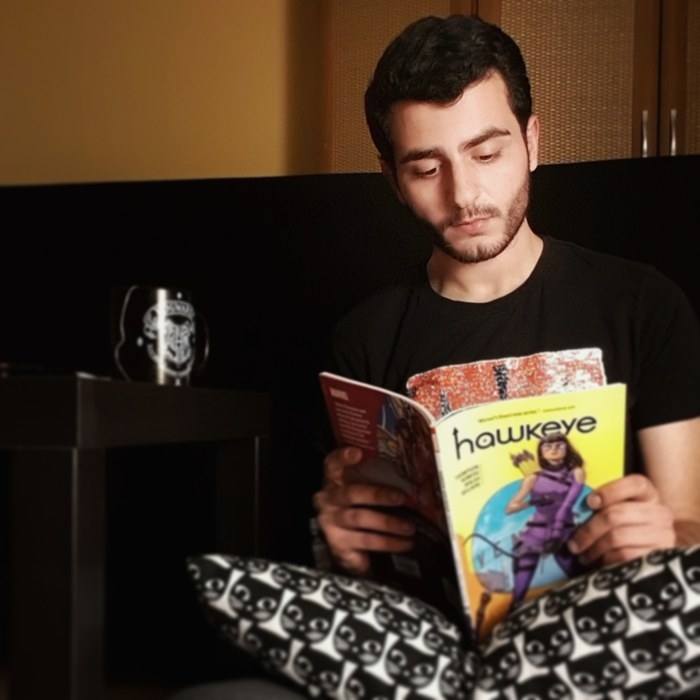
Anas Abdulhak is a Ringo Award nominated writer and editor from Syria. Known for combining poetry with introspective comics, they broke into the indie comic book scene with their self published works Eleutheromania, Objects in the Mirror, Their one-shot Etheres was published in 2023 from Source Point Press, and they’re one of the editors for the unSeen/unHeard: Disability and Neurodivergence anthology.
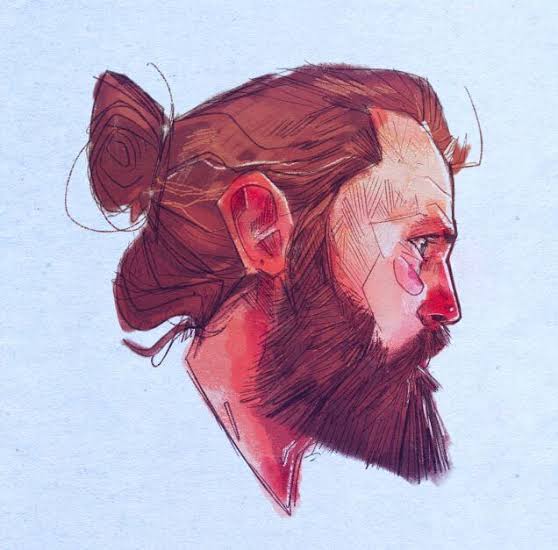
Dennis Menheere is a Ringo Award nominated Dutch artist and colorist known for his surreal painterly art style. He is the co-creator and artist of “Etheres” and has worked on several indie and IP projects as well as books for Titan, Vault, Image, WhatNot Publishing, and many others.
Priya Saxena (she/her or they/them) is a writer and critic based in New York City who enjoys reading queer comics and watching campy television. You can follow them on Twitter at @lettersofpriya.
